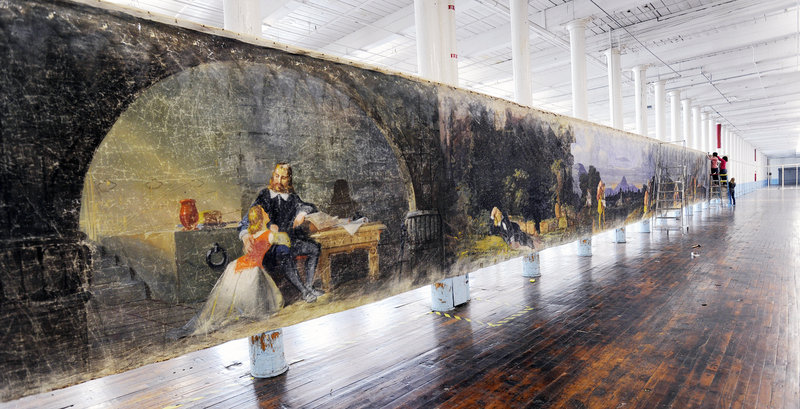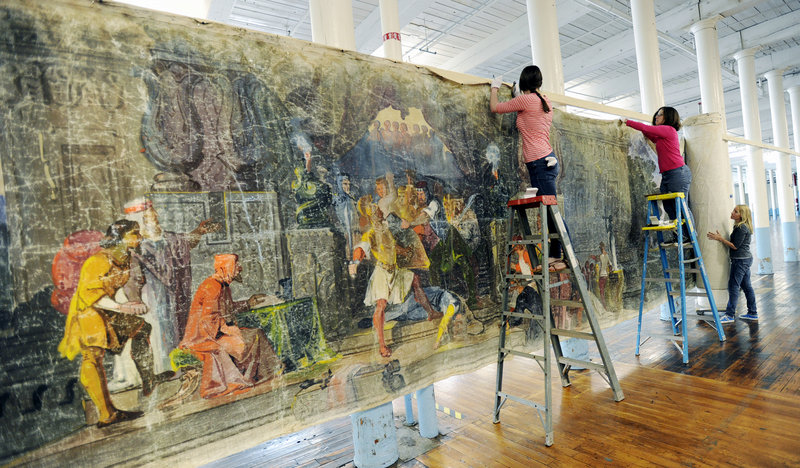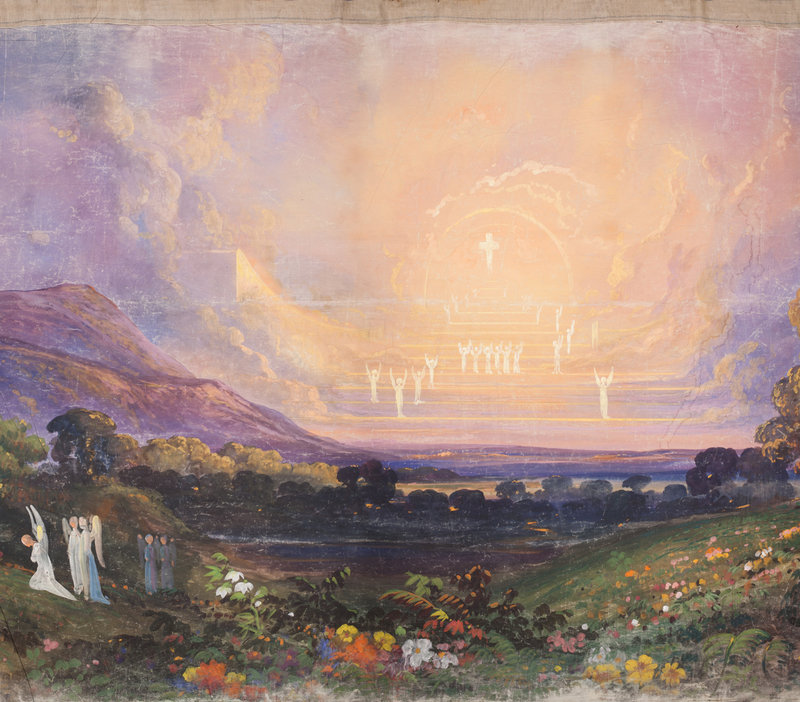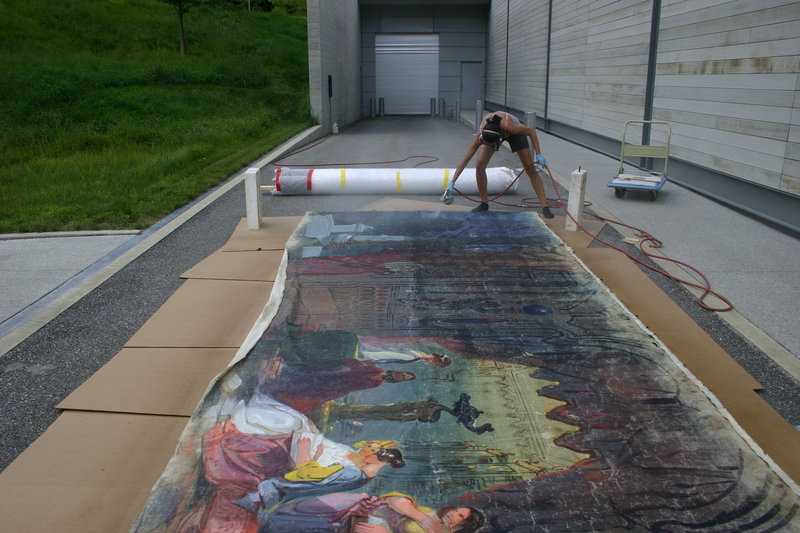SACO — Back in the day — before TV, before radio, before talking movies and silent movies and even before vaudeville — Americans flocked to theaters, public halls and churches to watch giant painted scrolls slowly unwind spool-to-spool behind a huge viewing window or proscenium.
With scenes painted on heavy cloth, these moving panoramas told epic stories, often with the accompaniment of a narrator and pianist.
For a brief period in America and overseas, painted panoramas were a hugely popular form of entertainment, akin perhaps to a concert today by a major pop star. They brought people together, created a stir and gave folks something to look forward to and talk about afterward.
And then they disappeared.
One technological advance after another rendered these painted panoramas obsolete, and they vanished from our culture and consciousness.
This summer, the Saco Museum resurrects one of these national treasures. Beginning Saturday, the museum will display an 800-foot scroll at its Main Street building and in the former loom room within the Pepperell Mill campus in downtown Biddeford. It will remain on view through Nov. 10.
It is the first time since the 1860s that the entire “Moving Panorama of Pilgrim’s Progress” will be on view. The museum spent 16 years working on this project, earnestly for the past three since it secured a Save America’s Treasures grant for more than $50,000. In all, the restoration project cost about $170,000.
It all began in 1996 when former museum director Tom Hardiman pulled the scroll out of storage in the museum basement. He intended to dispose of what was presumed to be a huge drop cloth, which people had been stepping over and around for decades.
But before he tossed it, he took a closer look and discovered the drop cloth was much more than he imagined.
“He unrolled it, and immediately could tell it was something very important,” said Jessica Skwire Routhier, the museum’s current director and project leader.
A little research revealed the treasure.
The Saco panorama was created in 1851, and presented to national audiences on a touring basis throughout the late 1800s. It illustrated John Bunyan’s 1678 religious allegory “The Pilgrim’s Progress,” an iconic piece of literature that became an important book on both sides of the Atlantic.
At a time when moving panoramas drew huge crowds, the “Pilgrim’s Progress” panorama was among the most popular.
The story begins in New York.
In 1848, artists Joseph Kyle and Edward Harrison May developed the idea for the panorama based on Bunyan’s story. They collaborated with a number of other artists, including Frederic Edwin Church, to provide designs for major scenes.
They created their tableau that year, and it debuted in New York to full houses and rave reviews. Nearly 200,000 people viewed it.
Eager to capitalize on their success, Kyle developed a second, revised panorama to tour in tandem with the first. In today’s world, we might think of these touring panoramas as the equivalent of a National Broadway Tour.
The panoramas created a cultural splash. Their arrivals were advertised in advance, and became big events. The promoters either traveled with a musician and technical support team to crank the device that moved the panorama on its spools, or hired local help.
The first panorama went as far as New Orleans. The second, as far as Detroit.
The fate of the first is unknown. But the second panorama made it to York County in Maine in 1864.
It was in York County that “The Moving Panorama of Pilgrim’s Progress” had its final showing, at the height of the Civil War.
“They had this brief period of popularity, and flamed into glory for 15 years. Then people got bored with them, and they were replaced by other things,” Routhier said.
In 1877, Biddeford real estate agent Luther Bryant bought the panorama from Charles A. Shaw, an inventor and local theater owner. Bryant hung the panorama, or part of it, in his Biddeford barn.
Some 20 years later, Bryant’s heirs donated the panorama to the York Institute, which is now known as the Saco Museum. In 1897, the York Institute exhibited the tableau for what is believed the last time, with one exception. In November 1999, the Portland Museum of Art displayed a section of the panorama.
Not coincidentally, Routhier worked as a curator at the PMA at that time, and that exhibition introduced her to the unusual cultural artifact. When she took over as director of the Saco Museum in 2009, she was familiar with the panorama, and knew its story and importance. She made it a priority to secure funding for its restoration.
The project has become a huge task. The panorama is approximately 800 feet long and 8 feet tall. During the 1990s, it was divided into four roughly equal sections of approximately 200 feet. One section was restored at that time for the PMA show.
The current project completes the restoration and also creates a replica.
The Saco Museum worked with the Portland imaging company Designtex. A team from Designtex made hundreds of digital images of the original and fabricated a replica. The replica will be shown in its originally intended format, as a moving panorama, throughout the summer and fall.
The original is hung on sturdy walls in the museum and on vertical pillars in the mill, strong enough to the support the weight of the muslin. The entire thing weighs 300 to 400 pounds.
The replica is a bit heavier, because it was made with a durable material capable of withstanding the rigors of being scrolled. It weighs 400 pounds or more. The challenge with the replica is building a device capable of showing it on its scrolls. The scrolling mechanisms were being tested and refined last week.
“It’s almost like reinventing the wheel,” Routhier said.
This is a major project for a little museum.
The annual budget of the Saco Museum is roughly that of this project: $170,000. The federal Saving America’s Treasures grant for $52,000 was a matching grant, meaning the Saco Museum had to raise that much to secure the grant. This project is the largest and most complicated ever attempted by the museum, said Peter Morelli, a museum trustee and development director for Saco.
He credited Routhier for taking it on and seeing it through.
“This is something we have been talking about for many years,” he said. “But in 2009, we hired a really good museum director, and she was able to get this project done. It’s incredible that it’s happening. It’s been a long time coming.”
It’s a source of pride for the city and the museum, he added.
“This is an incredibly important piece of a local institution,” he said. “We have this amazing thing. There are only about 20 left in the world, and ours is among the best and most elaborate.”
Routhier has become somewhat of an expert on the subject, and has spoken at national conventions about Saco’s moving panorama. In September, the museum will convene a symposium exploring topics related to the panorama. Speakers will come from the Metropolitan Museum of Art and the University of California, among other institutions.
She is proud of her work on the project, but credits her predecessors and many volunteers who have worked on it over the years. “I came in at the tail end of the project,” she said.
Staff Writer Bob Keyes can be contacted at 791-6457 or: bkeyes@pressherald.com
Twitter: pphbkeyes
Send questions/comments to the editors.







